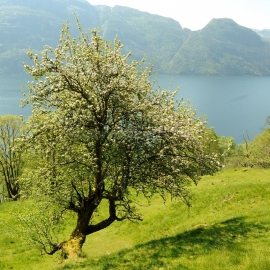



Organic European Crab Apple Seeds (Malus Sylvestris)
1.14 €
The native, wild Crabapple tree, Malus sylvestris, is an excellent hedging plant, commonly planted in mixed country hedges. It makes a decent, if unevenly shaped, ornamental tree for an average sized garden and it will also pollinate orchard apples.
-
Organic European Crab Apple (Malus Sylvestris)
The native, wild Crabapple tree, Malus sylvestris, is an excellent hedging plant, commonly planted in mixed country hedges. It makes a decent, if unevenly shaped, ornamental tree for an average sized garden and it will also pollinate orchard apples.
Native crabapples are very tough and will grow pretty much anywhere except full in shade or on very poor, sandy, dry soils. Malus sylvestris can reach 9 metres if it grows freely as a tree.
Crab Apple seeds have a deep dormancy within them, this requires a degree of patience to overcome and it is usually quite easy to get good levels of germination if the correct procedures are followed.
How to Grow
To begin soak the seeds in warm water for 24 hours and then drain away the water.
Next prepare a free draining substrate into which the seeds are to be mixed, this can be a 50/50 mixture of compost and sharp sand, or perlite, vermiculite.The chosen substrate needs to be moist (but not wet), if you can squeeze water out of it with your hand it is too wet and your seeds may drown and die. Mix the seeds into the substrate, making sure that their is enough volume of material to keep the seeds separated.
Place the seed mixture into a clear plastic bag (freezer bags, especially zip-lock bags are very useful for this -provided a little gap is left in the seal for air exchange) If it is not a zip-lock type bag it needs to be loosely tied. Then write the date on the bag so that you know when the pretreatment was started.
The mixed seeds first require a period of warm pretreatment to allow the seed embryo to mature and need to be kept in temperatures of 20 Celsius (68F) for a period of at least 2 weeks - it is not critical if it lasts a week or two longer than this. During this time make sure that the pretreatment medium does not dry out at any stage or it will be ineffective!
Next the seeds require a cold period to break the final part of the dormancy, this is easily achieved by placing the bag in the fridge (4 Celsius or 39F) for around 12 weeks. It is quite possible for the seeds to germinate in the bag at these temperatures when they are ready to do so, if they do, just remove them from the bag and carefully plant them up.
Once the pre treatment period has finished the seeds can be sown. Plant them about 5mm deep in a pot containing good quality compost. Keep them in a warm place at around room temperature and germination should begin within 1 or 2 weeks.
Do not expose newly sown seeds to high temperatures (above 25 Celsius) otherwise a secondary dormancy may be induced and the seeds will not germinate until they have been pretreated again. Keep the seedlings well watered and weed free. Growth in the first year is usually between 30 and 60cm and usually trouble free. Allow them to grow for 1 or 2 years before planting them in a permanent position.
